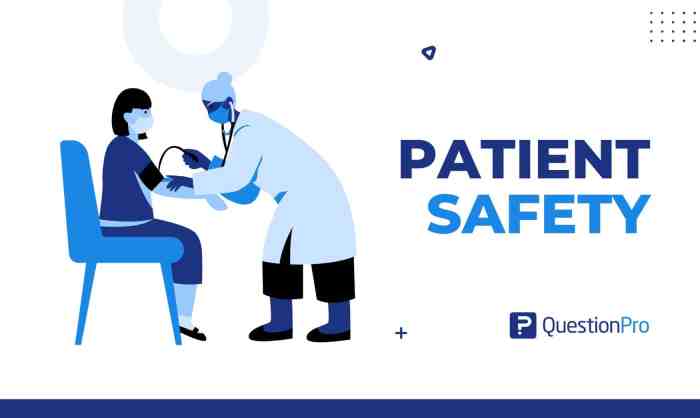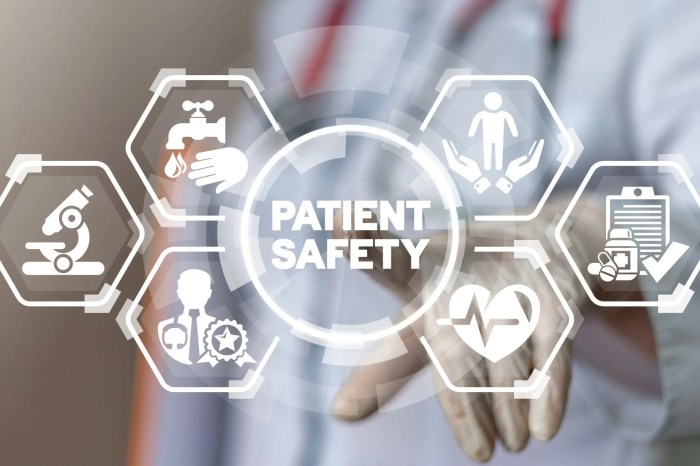
Beginning with Patient Safety Culture in Hospitals, the narrative unfolds in a compelling and distinctive manner, drawing readers into a story that promises to be both engaging and uniquely memorable.
Patient safety culture in hospitals is a critical aspect of healthcare that impacts the quality of services and patient outcomes. Understanding its importance and key components is vital in promoting a safe environment for all individuals involved.
Patient Safety Culture in Hospitals
Patient Safety Culture in hospitals refers to the collective values, attitudes, and behaviors that prioritize patient safety above all else in the healthcare setting. It involves creating an environment where healthcare professionals are empowered to speak up about safety concerns, errors are openly acknowledged and addressed, and continuous improvement is encouraged to prevent harm to patients.
Importance of Establishing a Strong Patient Safety Culture
Establishing a strong patient safety culture in hospitals is crucial for ensuring the well-being and outcomes of patients. When healthcare providers prioritize safety, it leads to a reduction in medical errors, infections, and adverse events. This, in turn, enhances the quality of care provided and increases patient satisfaction.
Impact on Healthcare Service Quality
A positive patient safety culture directly impacts the overall quality of healthcare services by fostering a culture of accountability, communication, and collaboration among healthcare teams. When everyone is aligned towards the common goal of patient safety, the risk of errors decreases, leading to improved clinical outcomes, reduced hospital readmissions, and overall better patient experience.
Benefits of Positive Patient Safety Culture
Improved patient outcomes
By promoting a culture where safety is a top priority, hospitals can reduce the occurrence of medical errors, infections, and adverse events, leading to better patient outcomes and faster recovery.
Reduced medical errors
A strong patient safety culture encourages healthcare providers to be vigilant, follow protocols, and speak up about potential risks, ultimately reducing the likelihood of medical errors that could harm patients.
Increased staff satisfaction
When healthcare professionals work in an environment that values their input, promotes open communication, and prioritizes safety, it leads to higher job satisfaction, lower burnout rates, and better retention of skilled staff members.
Enhanced reputation
Hospitals with a positive patient safety culture are more likely to be trusted by patients and the community, leading to a stronger reputation and increased patient loyalty.
Components of Patient Safety Culture
Patient safety culture in hospitals is influenced by several key components that work together to create a safe and effective environment for both patients and healthcare staff. These components play a crucial role in promoting and sustaining a culture of safety within healthcare organizations.
Role of Leadership
Effective leadership is essential in promoting and sustaining a positive patient safety culture in hospitals. Leaders set the tone for safety within an organization, establish clear expectations, and provide resources to support a culture of safety. They also prioritize patient safety in decision-making processes and encourage open communication about safety concerns.
Effective Communication
Communication among healthcare staff is a critical component of patient safety culture. Clear, open, and honest communication helps to prevent errors, identify potential risks, and address safety concerns promptly. Effective communication also fosters a culture of transparency and collaboration, allowing healthcare teams to work together to ensure the safety of patients.
Teamwork and Collaboration
Teamwork and collaboration are essential for fostering a culture of safety in hospitals. When healthcare staff work together as a cohesive team, they can identify and address safety issues more effectively. Collaboration allows for different perspectives to be considered, leading to better decision-making and improved patient outcomes. By working together towards a common goal of patient safety, healthcare teams can create a culture that prioritizes the well-being of patients above all else.
Strategies for Improving Patient Safety

Improving patient safety in hospitals requires a multifaceted approach that involves implementing best practices, leveraging technology and innovation, providing continuous training and education, and executing successful improvement projects or programs.
Best Practices for Implementing Patient Safety Initiatives
- Establishing a culture of safety that values open communication and reporting of errors.
- Implementing standardized protocols and checklists to reduce errors and enhance consistency.
- Encouraging multidisciplinary teamwork and collaboration among healthcare professionals.
- Engaging patients and their families in the care process to improve safety awareness and outcomes.
Use of Technology and Innovation to Enhance Patient Safety Culture
- Implementing electronic health records (EHRs) to improve information sharing and reduce medication errors.
- Utilizing barcode scanning systems to ensure accurate patient identification and medication administration.
- Adopting telemedicine and remote monitoring technologies to enhance patient monitoring and follow-up care.
- Leveraging artificial intelligence (AI) and machine learning to predict and prevent adverse events.
Impact of Continuous Training and Education on Improving Patient Safety
- Providing regular training on patient safety protocols, procedures, and best practices for healthcare staff.
- Offering ongoing education on infection control, medication safety, and other critical patient safety topics.
- Encouraging participation in simulation training and drills to enhance preparedness for emergency situations.
- Promoting a culture of lifelong learning and professional development among healthcare providers.
Examples of Successful Patient Safety Improvement Projects or Programs
- Implementation of a medication reconciliation program to reduce medication errors during transitions of care.
- Introduction of a falls prevention initiative to minimize fall-related injuries among hospitalized patients.
- Development of a hand hygiene campaign to improve compliance and reduce healthcare-associated infections.
- Integration of a patient safety reporting system to capture and analyze safety incidents for continuous improvement.
Measuring Patient Safety Culture

Patient safety culture in hospitals can be effectively assessed through various methods to ensure that healthcare organizations are providing a safe environment for both patients and staff. The evaluation of patient safety culture is essential for identifying areas of improvement and implementing strategies to enhance overall safety outcomes.
Methods of Assessment
- Surveys and Questionnaires: One common method is the use of surveys and questionnaires designed to capture the perceptions of healthcare staff regarding patient safety. These tools can help organizations understand the prevailing culture and identify areas for improvement.
- Observational Assessments: Direct observations of healthcare practices and interactions can provide valuable insights into the actual implementation of patient safety protocols within a hospital setting. Observational assessments help in evaluating compliance with safety guidelines and identifying potential risks.
- Incident Reporting Systems: Monitoring and analyzing incident reports can also serve as a crucial method for measuring patient safety culture. By reviewing reported incidents, organizations can identify recurring issues and implement corrective actions to prevent future occurrences.
Importance of Feedback and Data Collection
Feedback and data collection play a vital role in evaluating patient safety culture within hospitals. Continuous feedback from healthcare staff, patients, and other stakeholders helps in identifying gaps in safety practices and areas needing improvement. Data collection enables organizations to track trends, measure progress, and make informed decisions to enhance patient safety outcomes.
Utilizing Surveys and Assessments
Surveys and assessments offer a structured approach to capturing the perceptions of healthcare staff regarding patient safety. These tools provide valuable feedback on the existing safety culture, communication channels, teamwork dynamics, and overall commitment to patient safety. By analyzing survey results, organizations can identify strengths and weaknesses, prioritize improvement initiatives, and tailor interventions to address specific needs.
Using Data for Improvements
Data collected through various assessment methods can be utilized to drive improvements in patient safety culture. By analyzing data trends, organizations can identify areas of concern, establish benchmarks for performance, and track the effectiveness of implemented interventions. Data-driven decision-making enables healthcare organizations to focus resources on initiatives that have the greatest impact on enhancing patient safety and promoting a culture of continuous improvement.
In conclusion, Patient Safety Culture in Hospitals is an essential element in ensuring quality care and reducing medical errors. By establishing a strong culture of safety, healthcare facilities can enhance patient outcomes and overall service delivery.
Question Bank
What is the significance of patient safety culture in hospitals?
Establishing a positive patient safety culture is crucial for ensuring quality care, reducing errors, and improving patient outcomes.
How can leadership contribute to promoting patient safety culture?
Leaders play a key role in setting the tone for safety culture, providing direction, and ensuring adherence to safety practices.





